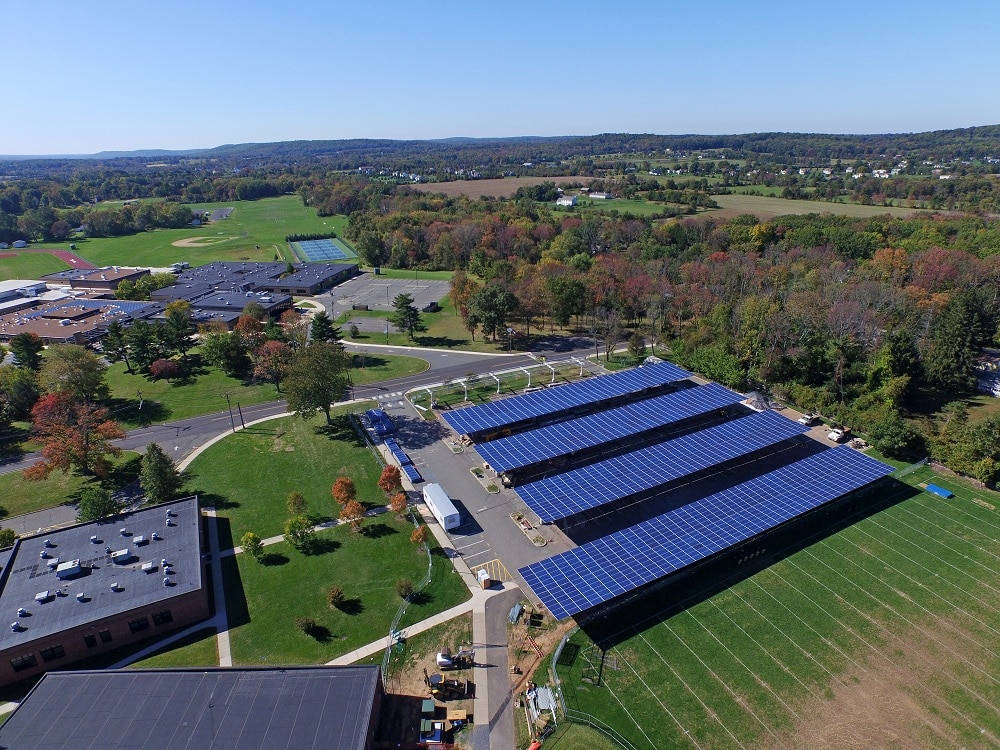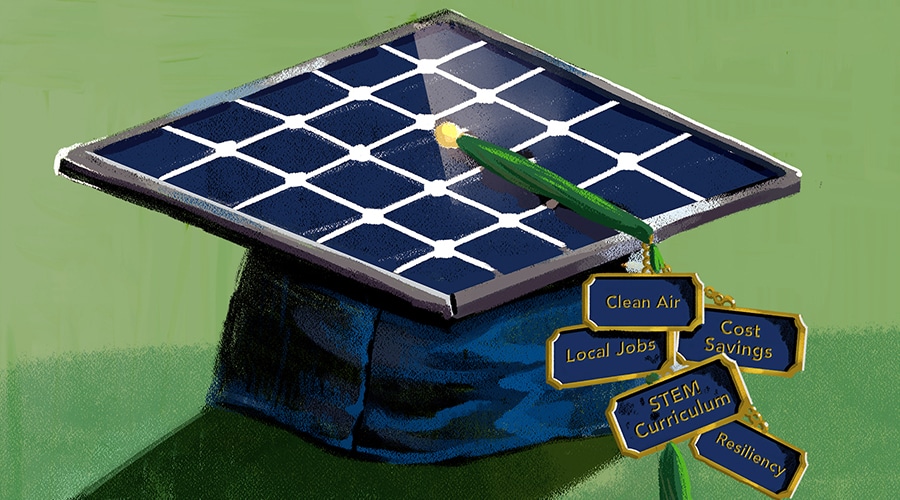Schools grappling with how to plan for optimal learning and safety for students returning this fall should also consider a long-term investment that stands to benefit students and entire communities: solar power. By outfitting educational buildings with energy tech that can operate off-grid, schools can mitigate the effects of natural disasters and other emergencies for both their students and their neighborhoods. Here are some examples of how communities all over the country are already doing it:
- Schools outfitted with solar + storage can be a failsafe against power outages. School districts of all sizes are investing in solar systems that enable them to generate clean power at little-to-no upfront cost, and some schools are taking things a step further by installing batteries that can store this energy for later use. After Hurricane Maria pummeled Puerto Rico in 2017, cutting off power for up to six months, donors raised funds to install solar microgrids—basically a solar array, energy storage, and an energy management system—at 10 institutions to provide grid support and serve communities. In the rural town of Tenino in Washington state, the regional utility is installing the area’s first large-scale microgrid, using solar panels on the high school, to provide back-up power when needed. Utilities in Colorado and Santa Barbara, California, are also exploring solar microgrids at schools in anticipation of shutoffs triggered by wildfires and other extreme weather events.
- Since 2012, the SunSmart E-Shelters Program in Florida has provided more than 100 public schools with small-scale solar systems and batteries to keep lights and electrical outlets operating so residents can seek refuge in the buildings during disasters. The solar-powered shelters, which can accommodate up to 500 people per school, proved their value after Hurricane Irma hit the state in fall 2017.
- In New Jersey, a solar + storage system at Hopewell Valley Central High School allows the school to serve as a warming or cooling station for displaced residents while also powering food refrigeration and emergency lighting.
- One of the best examples of designing for community resilience is in Salinas, California, where in 2018 Santa Rita Unified School District became the first district in the country to have 100 percent solar + storage at every school. The six microgrids—installed with no money down—can provide up to seven hours of electricity per battery charge, allowing students to shelter in place during blackouts so they don’t lose educational time. The microgrids also enable schools to serve as powered emergency response centers, or PERCs, that provide key services such as cell phone and electric vehicle charging, medical and triage support, and incident command centers in addition to emergency sheltering. “We have the immediate benefit that every single day, these kids will stay in school and learn,” said Ted Flanigan, president of EcoMotion, which oversaw the project. “And then… in the event of a major emergency, these schools would become huge community assets.”
- Schools can also help significantly reduce carbon emissions for the community – not just the school system. In California, Grossmont Union High School District in San Diego is adding battery storage at several sites to save on utility costs and to enable the schools to serve as virtual power plants that the local utility can tap into instead of (polluting) natural gas plants. Across Hawaii, some 1,267 classrooms are being cooled with “solar + storage” systems, helping districts save money and avoid expensive retrofits to central air systems.

To finance solar + storage, most schools opt for a power purchase agreement (PPA), in which a third party purchases, owns, and maintains the solar panels (and often the batteries), and the school or district agrees to buy the electricity produced for the length of the agreement, often 25+ years. PPAs are popular because a school can install solar with little-to-no upfront investment or ongoing maintenance costs, and typically pays a lower electricity rate. In the case of the Florida E-Shelters, the schools received the systems at no cost because the program received $10 million from the 2009 American Recovery and Reinvestment Act, in addition to funding from private and public utilities.
Given the many benefits of installing solar on schools—and the favorable financing options available—it’s hard to argue against adding both solar AND energy storage. In times of uncertainty, schools can reduce their energy footprints (and costs) while keeping students learning and providing critical support during emergencies. With little-to-no upfront cost, millions in savings, and a boost to community resilience, it’s a no brainer.















